



THE SOCIAL BURDEN OF OUT-OF-POCKET PAYMENTS IN CENTRAL AND EASTERN EUROPE Milena PAVLOVA, PhD Department HSR - Maastricht University INAUGURAL LECTURE HONORARY PROFESSOR CEREMONY 2-MAY-2017 CORVINUS UNIVERSITY OF BUDAPEST
www.assprocee2007.com Assessment of patient payment policies and projection of their efficiency, equity and quality effects. The case of Central and Eastern Europe Coordinated by MAASTRICHT UNIVERSITY List 2
OUT-OF-POCKET PAYMENTS ? consumers - patients healthcare service providers 3
OUT-OF-POCKET SPENDING - % OF TOTAL HEALTH EXPENDITURE, 2013 Source: Eurostat, OECD and WHO health data and Commission services calculations. See European Commission (2016), Joint Report on Health Care and Long-T erm Care Systems & Fiscal Sustainability, October 2016. 4
CHANGES IN OUT-OF-POCKET SPENDING, 1995-2011 80 74,4 70 67,5 60 West Europe (21) public expenditure % of total health expenditure CEE (14) public expenditure 50 West Europe (21) out-of-pocket expenditure 40 CEE (14) out-of-pocket expenditure 30 28,5 20 19,0 10 1995 1996 1997 1998 1999 2000 2001 2002 2003 2004 2005 2006 2007 2008 2009 2010 2011 5
INFORMAL PAYMENTS NOT REGISTERED PAYMENTS Widespread Peer-reviewed literature Some cases CEE countries but not only - Not reported All socio-economic groups - Physicians may earn an extra salary - % total health expenditure: up to 5.0% - Health Consumer Index survey commissioned by - Health Consumer Powerhouse included patient organizations - across European countries (n=602) 6
OUT-OF-POCKET PAYMENTS IN CEE COUNTRIES, 2010 7
LAST SERVICE INFORMAL AND QUASI-INFORMAL PAYMENTS (EURO), 2011 Bulgaria Hungary Ukraine Informal payment Yes N (%) 27 (4.0) 70 (9.7) 138 (25.5) for the last visit to Payment size Median 10.4 11.3 8.8 a physician Mean (SD) 17.1 (29.5) 25.7 (30.0) 19.1 (39.8) Informal payment for Yes N(%) 28 (14.4) 120 (44.1) 83 (40.5) the last hospitalization Payment size Median 25.6 52.2 43.8 Mean (SD) 74.7 (174.2) 68.6 (57.5) 103.8 (148.5) Pharmaceuticals Yes N(%) 31 (15.7) 54 (19.6) 168 (77.8) brought by the patient Total monetary value Median 15.6 8.5 62.1 to the hospital Mean (SD) 37.8 (99.3) 14.2 (16.1) 104.51(117.1) Medical supplies Yes N(%) 18 (9.1) 30 (10.9) 124 (57.7) brought by the patient Total monetary value Median 15.3 21.6 10.4 to the hospital Mean (SD) 276.7 (694.2) 33.6 (31.8) 21.0 (27.4) Bed linen and food No N(%) 168 (84.8) 241 (87.6) 108 (49.5) brought by the patient Yes N(%) 30 (15.2) 34 (12.4) 110 (50.5) to the hospital 8
DO INFORMAL PAYMENTS PRESENT A PROBLEM ? Undermine the role of health policy Hinder the estimation of health care expenditure Obstruct the attempts to improve cost-effectiveness Seldom quality improvements Barriers to access 9
ATTITUDES - GIFTS IN-KIND IN CEE ATTITUDES TOWARDS INFORMAL PAYMENTS IN CEE Attitude - cash informal payments Attitude - in-kind informal payments Pies show % of actual and potential heath care users Pies show % of actual and potential heath care users Negative attitude Indifferent Positive attitude 10
WHY INFORMAL PAYMENTS ? consumers Cultural & social perceptions - gifts and/or bribes Insufficient health care funding service providers - lack of pharmaceuticals and consumables - low salaries government Lack of control and accountability - no check-and-balance mechanisms 11
OUT-OF-POCKET SPENDING - % EQUIVALIZED ANNUAL INCOME, 2010 12
INABILITY TO PAY – VISITS TO PHYSICIANS & HOSPITALIZATIONS 13
MAIN FINDINGS Those who have greater needs but low income often forego health care or have to borrow money and sell assets to pay Borrowing money or selling assets is more common for hospital services, whereas foregoing utilization is more often applied in the case of outpatient services. 14
AGREEMENT WITH FORMAL PATIENT FEES (MEDIAN VALUES), 2009 15
WILLINGNESS TO PAY FORMAL FEES FOR IMPROVED SERVICES, 2010 16
KEY CONCLUSIONS & RECOMMENDATIONS Clear legal framework for out-of-pocket payments Transparency in policy decision-making: - defining basic healthcare services with no charges - setting fees for other services in the public sector - reinvesting revenues collected via patient fees Exemption mechanism to accompany formal patient charges given their catastrophic effects Effective strategy for dealing with informal patient payments 17
Milena Pavlova, PhD Department of Health Services Research Faculty of Health Medicine and Life Sciences Maastricht University P.O. Box 616, 6200 MD Maastricht, The Netherlands T +31 43 38 81705 m.pavlova@maastrichtuniversity.nl 18
Recommend
More recommend